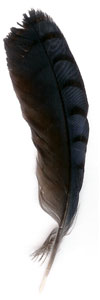


Steller's Jay (Cyanocitta stelleri) Description: Adults: Head, neck and upper back is sooty black, touched with streaks of cerulean blue on the forehead, and pale gray on the chin. They are blue on wings and tail. The terminal portion of tail and wings are crossed with fine black bars. Their bills and feet are black. Young birds are more extensively sooty and wing bars are faint or wanting. 
The Steller's Jay is about the same size as an American Robin.
Calls:
Steller's Jay make a variety of loud and harsh calls. Common call a harsh "shaar," and a rapid rattling "shek, shek, shek, shek." Range/ Habitat: Pacific coast from southern California to Alaska; resident and breeding throughout it's range. The Steller's Jay can be found in mixed forests, hardwood forests, coniferous forest, residential areas, and agricultural areas in forested landscapes. 
Click the range map to learn more about the distribution of Steller's Jays in Washington. Diet: In the fall, winter, and spring their food consists largely of acorns, chestnuts, berries, seeds, grain, insect, lizards etc. During the summer months they destroy and devour a great many eggs and young of smaller birds. They will watch a nest until the full compliment of eggs is laid before stealing the eggs. Nesting: Their nests consist of a bulky mass of fine twigs thickly plastered centrally with mud and lined with fine rootlets placed 6 to 30 feet high in evergreen tree thickets or near the edge of a clearing. They lay 3 to 5 eggs, usually 4, are pale bluish green, uniformly but moderately spotted with olive brown and pale rufous and with numerous shell markings of lavender. The eggs are usually laid from April to May.
Did you know?
Learn more about Steller's Jay Animal silhouettes available to purchase » Photos: Natures Pics
|